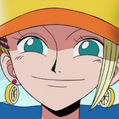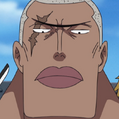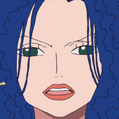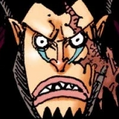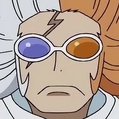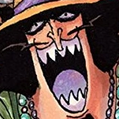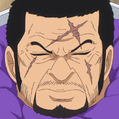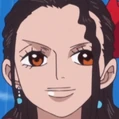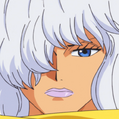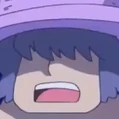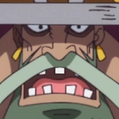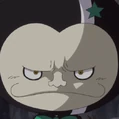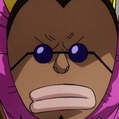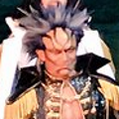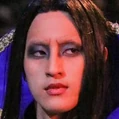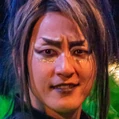Paramecia is one of the three Devil Fruit types. These fruits give the users a power that can affect their body, manipulate the environment, or produce substances. In general, Paramecia Devil Fruits are fruits that give their users powers other than transforming into elements, like Logias, or transforming into animals, like Zoans. Although they do not include powers that allow elemental or animal transformations, some of them are capable of other forms of transformations.[1] This is the most commonly seen class of Devil Fruits. In the edited dub (and later episodes of the uncut dub) and official subtitles, this class is called Paramythia.
Strengths
The Paramecia fruits grant users an ability that can be classified only as "Superhuman". The Paramecia fruits also contain the greatest variation of powers evident so far in the One Piece story, some of which even belonged to the strongest characters in the series.
The largest advantage of this group is that even physically weak fighters can make use of this fruit class, as demonstrated by both Robin and Mr. 3. The primary focus on the fighting styles of users does not have to rely on the physical strengths or fighting skills of the individual themselves, and is usually more focused on the users' creativity and initiative. The Paramecia group, therefore, can make fighters out of even weak individuals.
Although the abilities can be exploited and manipulated in a variety of ways, the extent of useful attacks or strategies depend greatly on the users themselves. Some consumers may encounter inspiration for a new attack after using a particular set of attacks for years, while others may never learn how to completely harness their skills. One such example is Brook, who although spent 50 years harnessing his Devil Fruit's abilities to keep himself alive, he never discovered the full extent of his powers until his separation from his crewmates led him to attempt to explore them.
Weakness

Two Paramecias fighting.
The Paramecia type is the only group containing powers or special traits that may be considered "useless" to the user, granting little or no real advantage whatsoever depending on the situation. As personally experienced by Luffy, his powers of elasticity proved almost useless after he first (accidentally) acquired them, and it was only much later on did he realized the fruit's utmost potential. In short, the aspect of the devil fruit being "useless" may sometimes be due to the user not being accustomed to it efficiently deploying the abilities they receive. Their abilities may also end up proving completely useless in some situations where they would normally otherwise have been quite formidable. Therefore, even the best of fighters may be strained to be able to use their abilities to the fullest.
Paramecia users are also considered the easiest to battle, since they can be predictable and often display their full abilities within a very short period of time. The results and capabilities of these fruits are therefore limited to the creativity of the user in any given scenario to overcome the limits and predictability of the fruits. However, this is only considered to be a general perspective, as Luffy thought of many innovative methods utilizing his powers, and some other fruits have highly versatile powers compared to others.
Some abilities of this type of fruit also add further implications, as in the case of Kuma and Decken; Both must keep their hands covered as their abilities are released from their hands. One might also argue that the same scenario would apply to Mr. 2 Bon Kurei — however, he is not seen to cover his hands.
Although other Devil Fruit types may also lead to the user being considered a "freak", none are more noted for this than the Paramecia group. This is due to some of the abilities granted by Paramecia fruits being considered far too strange or frightening for normal people to accept.[2]
Certain abilities with lingering effects — such as the Fuwa Fuwa no Mi and Hobi Hobi no Mi — would have all their effects deactivated upon their respective users fainting or dying; this becomes a weakness that the opponents would sometimes take advantage of, as the rebels of Dressrosa attempted to knock out Sugar to return the changes she made back to normal. Others — such as the Kage Kage no Mi and Mero Mero no Mi — will remain active even if the user is killed, and must be reversed by the user's own free will.
Other information
Paramecia are the most common type of Devil Fruit. They come in a variety of forms which can be divided into several subcategories.
With such a broad range of available powers, it is difficult to generalize the abilities offered by Paramecia fruits. However, it appears that the effects of this Devil Fruit type can be categorized into two basic groups: those which are based on a characteristic (such as elasticity or slowness) or an object (bombs, doors, etc.). Paramecia types are also distinguishable in the manner in which their powers manifest. They can either alter the user's current physical state (Luffy and Bon Kurei), directly affect their immediate environment and/or living things within proximity (Eustass Kid, Blueno or Whitebeard), or affect both of these conditions (Jewelry Bonney, Trafalgar Law and Emporio Ivankov).
How to trigger the fruit’s power can also differ from user to user. For instance, the Gomu Gomu no Mi, Yomi Yomi no Mi, and Sube Sube no Mi have powers that are active at all times, while others such as the Noro Noro no Mi and Hana Hana no Mi require self-activation.
There are also many types of Paramecia that could be easily mistaken as Logia, either due to the user's ability to release near-limitless amounts of a particular substance (or energy) in relation to the power their fruit gives (Mr. 3, Kalifa, Musshuru, and Magellan); or that they are able to mimic the properties of certain existing matter (Mr. 1, and Jozu). These types of Paramecia are not to be confused as Logia, though, since the users of the former category cannot convert themselves into their respective substance, nor do those particular substances count as actual elements, and neither can those from the latter sort generate the same aspect from their bodies that they are capable of transforming into. Basically, while an elemental Paramecia can allow the user to generate, control and be immune to their element, they can not actually become that element or regenerate, like a Logia user, although one exception had been seen so far, as when Baby 5 uses her devil fruit to turn herself into a weapon of her choice, she can regenerate herself fully if destroyed, but only when transformed into a weapon.
Users
- See also the associated category: Paramecia Devil Fruit Users.
- †: the character is deceased.
- ?: the character's status is unknown.
- ≠: the character is non-canon.
- ‡: the character is no longer part of this group. Hovering the symbol may give further details.
- *: other relevant information. Hovering the symbol gives further details.
List of Known Paramecia Fruits
- Gomu Gomu no Mi (English versions: Gum-Gum Fruit): Gives the user a body made of rubber and immunity to electricity. Also gives near-immunity to blunt attacks and weaponry, such as bullets and cannon balls.
- Bara Bara no Mi (English versions: Chop-Chop Fruit): Allows the user to split their body into separate parts. Also gives immunity to slashing attacks.
- Sube Sube no Mi (English versions: Slip-Slip Fruit/Smooth-Smooth Fruit): Makes the user's skin slippery. In Alvida's case, the fruit caused extreme weight-loss as it caused even her fat to slip off her body.
- Kilo Kilo no Mi (English versions: Kilo-Kilo Fruit): Allows the user to change their body weight, but without changing their body size.
- Bomu Bomu no Mi (English versions: Bomb-Bomb Fruit/Boom-Boom Fruit): Gives the user's body and secretions explosive properties and immunity to explosions.
- Hana Hana no Mi (English versions: Hana-Hana Fruit/Flower-Flower Fruit): Allows the user to sprout body parts on any surface, including their own body.
- Doru Doru no Mi (English versions: Wax-Wax Fruit): Allows the user to create and manipulate wax.
- Baku Baku no Mi (English versions: Munch-Munch Fruit): Allows the user to eat anything and merge with it.
- Mane Mane no Mi (English versions: Clone-Clone Fruit): Allows the user to physically transform into another sentient being they've come in contact with.
- Supa Supa no Mi (English versions: Dice-Dice Fruit): Allows the user to transform any body part into a blade, thus gaining the hardness of metal and slashing abilities.
- Toge Toge no Mi (English versions: Spike-Spike Fruit): Allows the user to grow spikes from their body.
- Ori Ori no Mi (English versions: Cage-Cage Fruit/Bind-Bind Fruit): Allows the user to place shackles on opponents with a mere touch as well as form various forms of constraints.
- Bane Bane no Mi (English versions: Spring-Spring Fruit/Boing-Boing Fruit): Allows the user to turn their limbs into springs.
- Ito Ito no Mi (English versions: String-String Fruit): Allows the user to create strings to do various things such as control people like puppets.
- Noro Noro no Mi (English versions: Slow-Slow Fruit): Allows the user to slow objects and people for 30 seconds with a special beam.
- Doa Doa no Mi (English versions: Door-Door Fruit): Allows the user to create doors/portals anywhere, including walls, living beings, and the air.
- Awa Awa no Mi (English versions: Bubble-Bubble Fruit): Allows the user to create and control soap bubbles that can clean anything, including strength.
- Beri Beri no Mi (English versions: Berry-Berry Fruit): Allows the user to split their body into many berry shaped balls.
- Sabi Sabi no Mi (English versions: Rust-Rust Fruit): Allows the user to rust objects, including organic material.
- Shari Shari no Mi (English versions: Wheel-Wheel Fruit): Allows the user to turn their limbs into wheels.
- Yomi Yomi no Mi (English versions: Revive-Revive Fruit): Grants the user a second life, as well as allowing the user to have their soul leave the body in the form of astral projection.
- Kage Kage no Mi (English versions: Shadow-Shadow Fruit): Allows the user to manifest and control shadows in various ways.
- Horo Horo no Mi (English versions: Hollow-Hollow Fruit): Allows the user to create and control ghosts with purposes ranging from depressing and/or explosive attacks to information gathering.
- Suke Suke no Mi (English versions: Clear-Clear Fruit): Allows the user to become invisible, and turn whatever they touch invisible, including people.
- Nikyu Nikyu no Mi (English versions: Paw-Paw Fruit): Allows the user to repel anything they touch, including intangible and abstract concepts such as fatigue and pain.
- Ope Ope no Mi (English versions: Op-Op Fruit): Allows the user to generate a light blue sphere-like room, in which they can manipulate all the things inside.
- Mero Mero no Mi (English versions: Love-Love Fruit): Allows the user to turn people that feel attraction for them into stone.
- Doku Doku no Mi (English versions: Venom-Venom Fruit): Allows the user to create and manipulate different kinds of poison.
- Horu Horu no Mi (English versions: Horm-Horm Fruit): Allows the user to inject different hormones into their own body as well as others' bodies in order to alter them in some way, including change to one's gender, temperature, pigment, development, and tension.
- Choki Choki no Mi (English versions: Snip-Snip Fruit): Allows the user to transform parts of their body into scissors. Anything cut by these scissors briefly gains the properties of paper.
- Gura Gura no Mi (English versions: Tremor-Tremor Fruit): Allows the user to cause shock waves by shattering the air, through which the user can create earthquakes and tsunamis. Considered to be the most powerful Paramecia.
- Fuwa Fuwa no Mi (English versions: Float-Float Fruit): Allows the user to fly and levitate non-living things by reversing gravity.
- Woshu Woshu no Mi (English versions: Wash-Wash Fruit): Allows the user to literally wash and fold a person, as if they were laundry on a clothes-line. It also makes a person's heart cleaner.
- Mato Mato no Mi (English versions: Mark-Mark Fruit): Allows the user to lock onto the last person their hand has touched as a target and launch projectiles at said target without missing.
- Buki Buki no Mi (English versions: Arms-Arms Fruit): Allows the user to turn any of their body parts into various weapons.
- Guru Guru no Mi (English versions: Spin-Spin Fruit): Allows the user to turn their body and body parts into powerful fans and/or propellers.
- Hobi Hobi no Mi (English versions: Hobby-Hobby Fruit) : Allows the user to turn people into toys and halts the aging process.
- Bari Bari no Mi (English version: Barrier-Barrier Fruit): Allows the user to create barriers.
- Nui Nui no Mi (English version: Stitch-Stitch Fruit): Allows the user the ability to stitch things together and un-stitch them like nothing happened.[citation needed]
- Giro Giro no Mi (English version: Glare-Glare Fruit): Allows the user to see through everything and read people's mind and memories.
- Ato Ato no Mi (English version: Art-Art Fruit): Allows the user transform other people and objects into art.
- Jake Jake no Mi (English version: Jacket-Jacket Fruit): Allows the user to transform into a jacket and control the body of whomever wears them.
- Pamu Pamu no Mi: Allows the user to expand and rupture their body, as well as any inorganic object they touch.
- Sui Sui no Mi: Allows the user to swim freely through the ground and walls.
- Hira Hira no Mi: Allows the user to treat anything they touch as though it was as thin and fluttering as fabric.
- Ishi Ishi no Mi: Allows the user to assimilate and manipulate stone.
Non-Canon
- Goe Goe no Mi: Allows the user to create powerful sound waves by shouting. (Movie 1)
- Kama Kama no Mi (English dub: Sickle-Sickle Fruit): Allows user to manipulate air into sharp projectiles. (Warship Island arc)
- Hiso Hiso no Mi (English dub: Whisper-Whisper Fruit): Allows user to communicate with animals by hearing its thoughts. (Warship Island arc)
- Kachi Kachi no Mi: Allows the user to harden their body and raise body temperature. (Movie 2)
- Nemu Nemu no Mi: Allows the user to induce sleepiness. (Ocean's Dream Arc, game only)
- Atsu Atsu no Mi (English version: Heat-Heat Fruit): Allows the user to manipulate heat. (Lovely Land Arc)
- Mini Mini no Mi (English version: Mini-Mini Fruit): Allows the user to change body size. (One Piece Round the Land, Z's Ambition Arc)
- Noko Noko no Mi: Allows user to create and control poisonous spores. (Movie 9)
- Ami Ami no Mi (English versions: Net-Net Fruit): Allows the user to swallow anything and turn the material and himself into a net. (Little East Blue Arc)
- Kopi Kopi no Mi: Allows the user to copy the abilities of another Devil Fruit user.
- Modo Modo no Mi: Allows the user to return anything the user touches to a younger age. (Movie 12)
- Mosa Mosa no Mi: Allows the user to fasten the grow of plants and possibly other things. (Movie 12)
- Peto Peto no Mi: Allows the user to control animals and humans.
SBS
- Gero Gero no Mi: Makes the user disgusting. (SBS Volume 4)
- Samu Samu no Mi (English versions: Samu-Samu Fruit): The user can only tell bad jokes. (SBS Volume 7)
Translation and Dub Issues
超人, usually read as chōjin, literally means "super-human". Paramecia (pl) though are in Latin context unicellular ciliate protozoa, also known as Lady Slippers.
In the Viz Manga and edited FUNimation dub, the word is translated into Paramythia, but in the uncut FUNimation dub, the word keeps its original name.
Trivia
- In One Piece: Gigant Battle! 2 New World, Donquixote Doflamingo is considered a Paramecia Devil Fruit user. This was long before his powers were revealed to be from the Ito Ito no Mi.
- The word "Paramythia" is a Greek word that means fairy tales.
- Out of all the known Paramecia Devil Fruit users, the only one who has died is Edward Newgate.
- Coincidentally, most of the Donquixote Pirates are Paramecia Devil Fruit users (Bellamy, Trafalgar Law, Baby 5, Buffalo, Jora, Violet, Senor Pink, Sugar, Diamante, Gladius, and Doflamingo himself).
References
- ↑ 1.0 1.1 One Piece Manga and Anime — Vol. 1 Chapter 1 and Episode 1, the concept of Paramecia Devil Fruits and Devil Fruits in general is introduced when Luffy eats the Gomu Gomu no Mi.
- ↑ One Piece Manga and Anime — Vol. 41 Chapter 391 and Episode 275, Nico Robin's Devil Fruit powers made her an outcast on her home island of Ohara. The villagers and other children considered her a freak of nature.





